Archive for April, 2020
April 12th, 2020 by dave dorsey
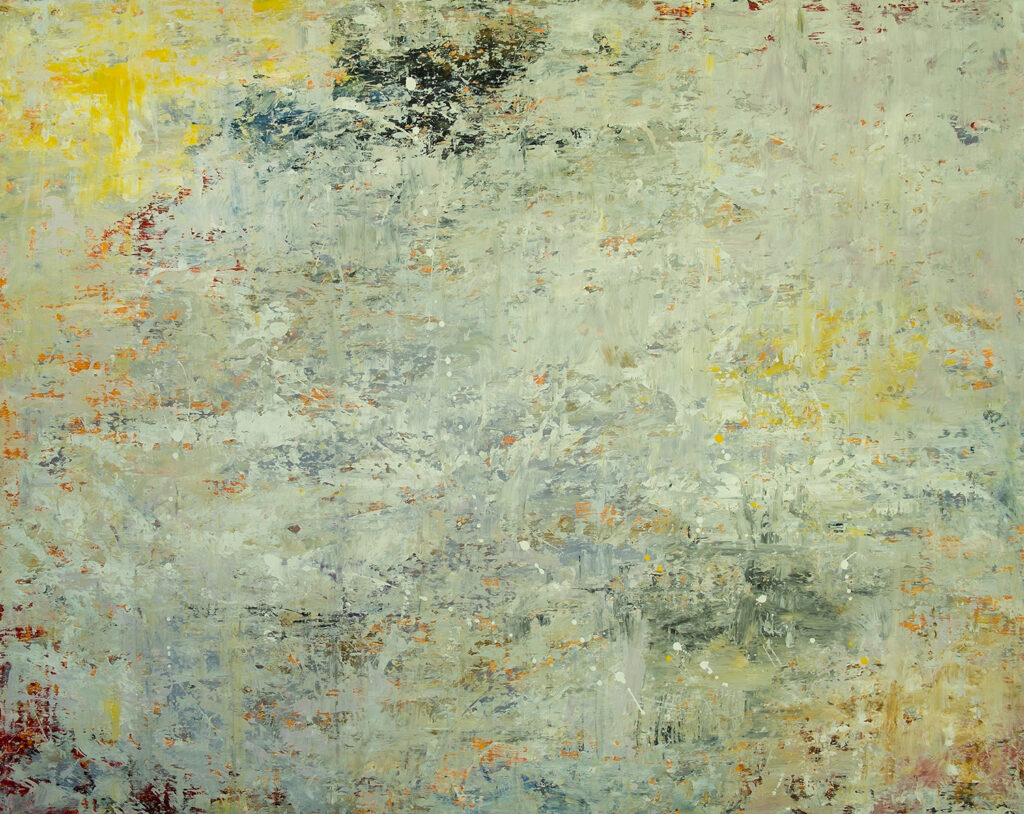
Winter, Richard Harrington, acrylic on panel, 48: x 60″
I stumbled across this abstract from my Oregon friend, Rick Harrington, a couple weeks ago, because I was intrigued by something he’d posted on Facebook and wanted to see what he was up to lately. He wrote that he’d completed it a couple years ago, as part of a triptych: all three paintings are posted at his site. He’s been painting what I would call color field barns and color field animals for years. This is presumably a snowstorm, which is already a fairly uniform field of white, but what he’s done here with that foreground white-out is wonderful: the way the intense under-layers of color suggest both natural and internal phenomena, late autumn reds, the yellow glare of the sun in the upper left, and memories of greenery, as if he just went all out with saturated tones in his first strike on the canvas and then started concealing everything he’d done so that you get just little glimpses, hints, of what’s there underneath, which makes the image as much a representation of human psychology as it is a Turner-esque vision of a storm. He paints his barns mostly with rags, and could easily have dispensed with brushes for this one, but I didn’t ask. I was too busy praising him.
April 9th, 2020 by dave dorsey
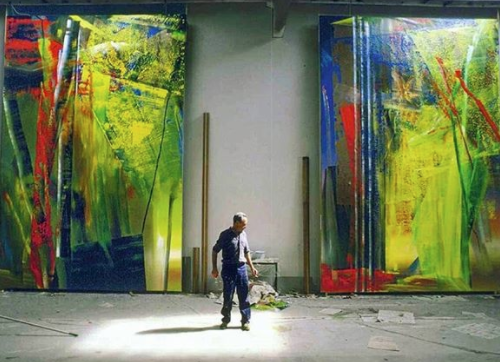
Gerhard Richter with his work
The shot of these two huge abstracts, with Gerhard Richter dwarfed by his work while posing in the shaft of light, appeared on Instagram at abstrac.ted. I can’t find anything quite like them in the compendium of Richter’s work over the decades at Gerhard Richter. I’m wondering if this means he has recently completed these, and if so, it’s an interesting shift in his work. With the exception of a series he did in 2005, all entitled Forest, these two paintings distinguish themselves from almost all of his earlier, extremely flat
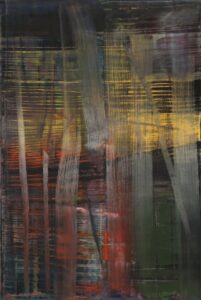
Forest
abstracts, obedient to Clement Greenberg’s advocacy of flatness as painting’s most essential, defining characteristic–what, in retrospect, seems like either the silliest or the most obvious proposition about art ever to be embraced in such a hugely influential way. In the bulk of his abstract paintings, Richter experiments with the effects he can get by using large amounts of multiple colors, smearing, masking, scraping, scumbling (on a large scale) one color into another in various ways. In the earlier work, he achieves suggestive effects of luminosity and hints of depth—so that some areas of paint seem to recede to an area just behind the surface. In the Forest series, this is more pronounced: you can discern what might be tree trunks in a foreground, or an underwater scene with tiers of aquatic plant life, against an indeterminate soup behind them, in a way that feels slightly Klee-like. Landscapes blur into twilight. But in this pair of huge canvases, the sense of space is vast, giving a sense of receding vistas. Light seems to shoot down through layers of foliage or enormous skylights, and the vertical shafts to the left in each canvas suggest buildings, or maybe the geometric angles of Richter’s studio itself. In the painting on the left, down in the lower right corner, the rectangular area of softened light seems like a window that offers a glow reaching the viewer from miles away. More than most of his abstraction in the past, this work from Richter, if it’s recent, gives reason to hope he’s trying to find a closer, expressionist truce between abstraction and his celebrated genius as a realist.
April 6th, 2020 by dave dorsey
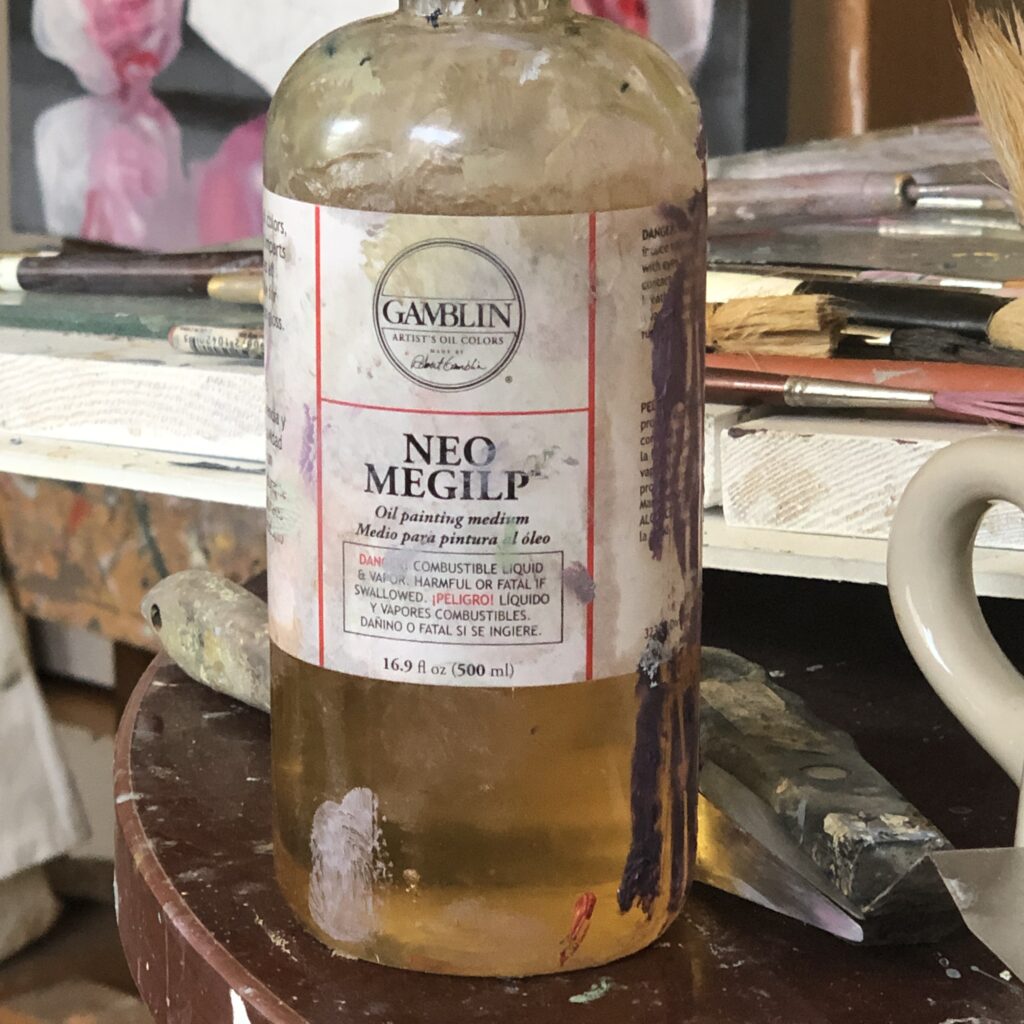
My new favorite medium.
I’ve been joking with a number of people that having complied with the social isolation required around the world to fight COVID-19, I can’t tell the difference between this and my ordinary life. Such is painting. I still make furtive trips to the supermarket and Home Depot. I paid cash for one small purchase recently and my fingertips did an absurd dance with the clerk’s in our attempt not to touch each other. Meanwhile, running along the Erie Canal’s towpath yesterday, I felt as if dozens of erstwhile isolationists had fled to that nearly empty channel of water, far more people than I would normally see at this time of the year. Walkers, runners, cyclists and in-line skaters were easily able to keep their distance and most were friendlier than they are in the aisles of stores. Maybe I’m just noticing for the first time how eye contact at Wegmans is as rare as on the streets of Manhattan, where people walk under an unspoken edict never to smile at anyone or acknowledge individual faces in the packed flow of pedestrians moving along Fifth Avenue. (Fifth Avenue is as dry, figuratively speaking, as the Los Angeles River these days.)
All of these sequestered hours provide ample time to paint, though I’ve noticed in myself and a number of others—Christopher Burke’s latest post on Instagram talked about his creative rut—that this weird, nearly universal state of suspended animation in society casts a pall on individual effort, for some reason. I’m still painting every day, often for six hours, and making steady progress, but always with an irksome sense that I work more slowly than I would like—yet that doesn’t inspire me to put in longer hours.
So I’m busy enough to be posting new work every few weeks, but I’ve withdrawn to a great degree from Instagram, and have been lax in my posts here, partly because of this languishing sense that everything has come to a halt, but mostly because I’m working on a long series of salt water taffy paintings. I don’t want to post them piecemeal, but rather to wait until the series is nearly done—which will take more than a year. I want to excavate all the possibilities from this radical narrowing of my work. I spoke recently with Rick Harrington about this, telling him that I’m rankling a bit from the constraints of doing what feels in some ways like the same thing over and over again—which is entirely the point of the series, to see how a simple subject accurately rendered can end up working the way an abstract works—and he said, from his long experience with his abstracted barns, that you can learn much by sticking with a particular subject for years and years. After years of struggling to emerge from a fog that resulted from the aftereffects of anesthesia during surgery on his throat, he is back in fourth or fifth gear, reaching a new plateau in his efforts—though the sudden stasis in the economy seemed to threaten his momentum in his galleries. (It hasn’t just yet.) Of this, I’m certain: boxing myself into this narrow line of work will provide ample reward and allow me to learn a lot, and could open some doors. But that doesn’t make it feel any less confining, and doesn’t make it any more pleasant to become a reluctant Punxsutawney Phil and renounce a regular dose of likes on Instagram. It all comes down to hours at the easel; like everything else in life, it’s mostly a matter of showing up and letting the work happen. And maybe pushing for another couple hours beyond the point where you want to get outside and forget the canvas until tomorrow.
One thing I happen to have learned already, in my pursuit of a certain flow of paint in this series, is that from now on, I’m a lifelong convert to Gamblin’s Neo Megilp medium. It is a gel, rather than a fluid, a safer version of Maroger’s, a medium its inventor claimed was the medium of the Old Masters. It’s lead-based, while Neo Megilp uses no lead. Fairfield Porter mixed his own Maroger’s and you can see it in the quality of his marks. I don’t know why I haven’t tried it before now, but it’s marvelous—it gives a consistency to the paint that allows a fluent application, without dripping or visible thinning of the pigment, and stays ductile for a long time, allowing wet-on-wet technique, which is my goal. And a little goes a long way, so that the bottle I’m currently depleting will last for many paintings, even large ones. It’s a joy.
April 3rd, 2020 by dave dorsey
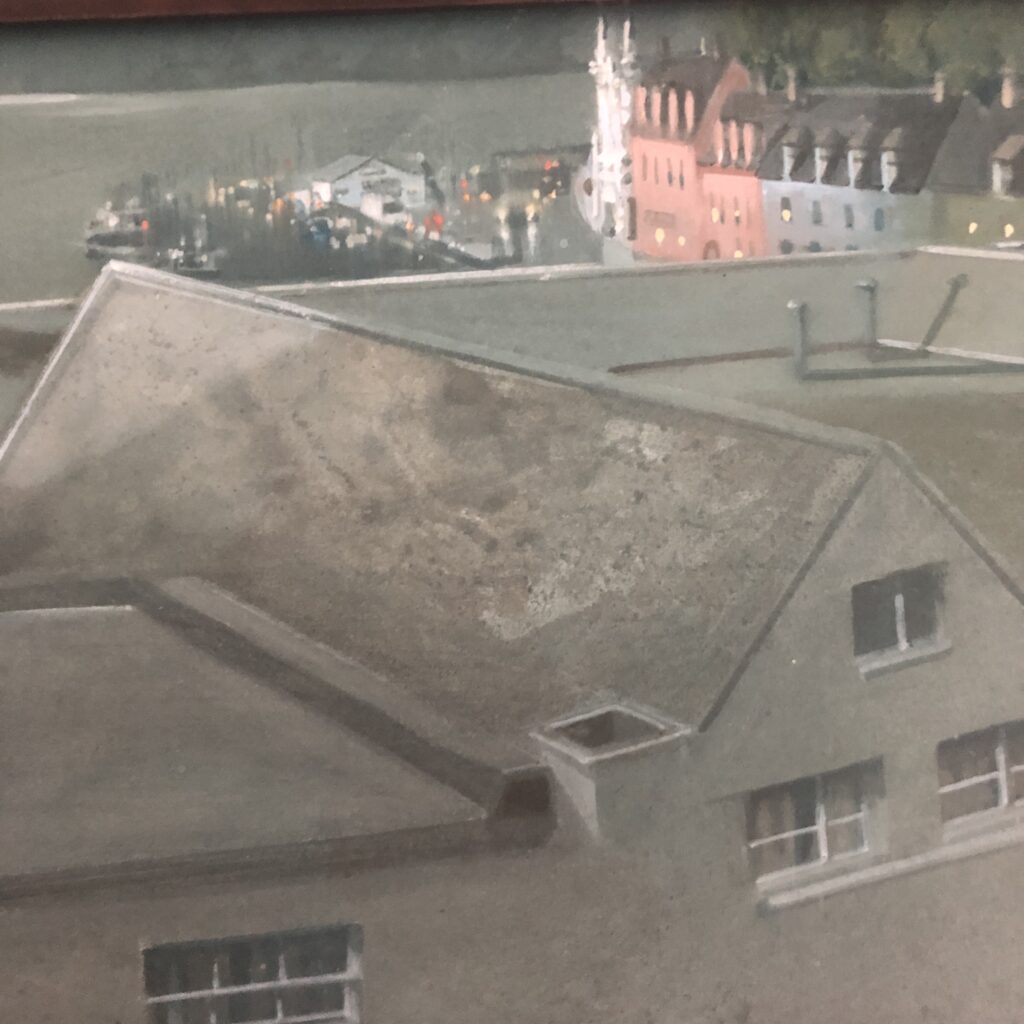
Skye, Chris Baker, gouache, detail.
About 200 hundred pages into the Kilmartin translation of Swann’s Way—I came back to this passage after finding a similar observation in the second book—Proust talks about how his fiction is non-intellectual, and that his lack of ideas originally persuaded him that he couldn’t be a writer. A La Recherche du Temps Perdu shows how his pursuit of love and friendship and social status kept him from discovering his vocation, though ironically the story of his immersion in the illusions of society becomes the actual content of the novel he was unable to write because he was living the events of the book. He had to get lost to find himself.
Here is the passage that says so much, for me, about visual art and the lack of intellectual content or meaning in the paintings I love most (it’s appropriate that visual art was one of the primary inspirations for Proust’s novel and for his style of writing):
Then, quite independently of these literary preoccupations and in no way connected with them, suddenly a roof, a gleam of sunlight on a stone, the smell of a path would make me stop still, to enjoy the pleasure that each of them gave me, and also because they appeared to be concealing, beyond what my eyes could see, something which they invited me to come and take but which despite all my efforts I never managed to discover. Since I felt that this something was to be found in them, I would stand there motionless, looking, breathing, endeavoring to penetrate with my mind beyond the thing seen or smelt . . . It was certainly not impressions of this kind that could restore the hope I had lost of succeeding one day in becoming an author and poet, for each of them was associated with some material object devoid of intellectual value and suggested no abstract truth.
He ignores these intimations for years because they offer him no ideas. He spends years believing he had no talent, no creative virtues, as a result of this lack of intellectual originality. By the end of the novel, the elimination of ideas in favor of the raw phenomena of life, the matrix of felt experience, becomes his sextant, enabling him to bring to life a complex and beautifully superficial world, saturated with a reality to which its inhabitants remain deaf and blind, except in brief, revelatory moments—and those simple moments are what his art is dedicated to triggering, the opening up of a world, intensely familiar but also fresh, surprising, and new. In other words, alive. And through all of it runs the Platonic suggestion that these glimpses are also glimpses of something incorruptible and timeless, hints that the material world is merely the tip of an iceberg invisible to conscious thought.




